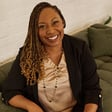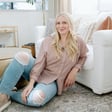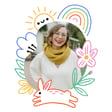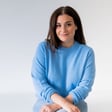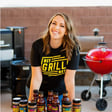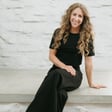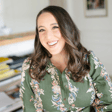Emotional Struggles and Selling Art
00:00:05
Speaker
I really struggled with selling my paintings just like emotionally because I felt really guilty making people pay money for something I really like doing. And I remember this person saying, they are not only paying for the canvas with the paint on it. They are paying for the number of years that you've done training. They're paying for your studio space and they are paying for
00:00:35
Speaker
you to be alive and healthy and well enough to be inspired to like create things basically.
Introduction of Blakely Little and Collaboration with Anthropologie
00:00:46
Speaker
Welcome to the Brands at Book Show where we help creative service-based businesses build their brands and find more clients. I'm your host, Davy Jones.
00:00:58
Speaker
Today's guest is artist Blakely Little of Blakely Made. And I'm really excited about this episode because Blakely is the first artist that we've had on the show. Krista actually has one of her paintings hanging right next to her desk. We've known Blakely since she was in high school. And it's been really fun watching her career evolve, especially recently.
00:01:18
Speaker
If you were to walk into an anthropology store today, you would find a line of dishware with Blakely's art on it. So in this episode, we chat about making a living as an artist and her recent collaboration with anthropology. But even if you're not an artist, there is so much great insight from Blakely in this episode about creative work
00:01:39
Speaker
from staying inspired to creating even when you don't feel like it and more. Before we get to the interview, I want to mention that Blakely is trying to get a picture of someone holding something from her collaboration product line with Anthropologie in every store across the US. So if you have an Anthropologie near you, head on over there, take a picture with something from the line
00:02:00
Speaker
and be sure to tag at BlakelyMade in that picture. If you don't have an anthropology store near you, you can find a link to those anthropology products in the show notes so that you can check them out. Be sure to check out the show notes at davianchrista.com for the resources that we mentioned during this episode, and I'd like to hear from you about what kind of content you'd like to see on the Brands That Book podcast as we move forward. I'd also like to know what episodes you've enjoyed so far and why.
00:02:26
Speaker
So to leave your feedback, head on over to the Davey and Krista Facebook page and send us a message.
Davy Jones' Personal Update
00:02:32
Speaker
Now onto the episode. All right, Blakely, thank you so much for joining me on the show this morning. I'm so glad that we were finally able to make this work.
00:02:50
Speaker
I know. I know. I'm happy to be here. We've got lots of fun things to talk about. I know you had a busy May-June. We also had a busy May-June. This is my first. Different reasons. Different reasons. This is my first episode back post-baby.
00:03:04
Speaker
Well, congratulations to you and Krista. Yeah, thank you. Maybe Jack is adorable. Thank you. We think so too. We keep on asking ourselves, are we just biased? We're probably a little bit biased, but we think he's pretty darn cute. Maybe a little, but he is real cute.
Blakely's Artistic Journey and Style Development
00:03:21
Speaker
Well, I've been really excited for this interview for a number of reasons. One, because we've known each other for a long time.
00:03:27
Speaker
And two, because you are the first artist that we've had on the show. And when I came up with a original list of people that I wanted to reach out to, Krista was actually, you know, you got it, you got to reach out to Blakely. And I thought that would be a great idea. So yeah, I'm fine. I'm glad that we finally got you out here. And then also going back to I think I think we met for the first time you were either in high school or just graduated from high school, right?
00:03:54
Speaker
I think I was in high school still, yeah, something like that. Yeah, so we both have a background in young life and I helped out, so we both are from the same area and I think you were a junior leader and I was a leader.
00:04:06
Speaker
and we share good mutual friends. So that was the first time and I don't remember and this is a perfect way to kind of kick off. We have so much stuff to talk about. And for those of you who don't know Blakely, you can actually see her art in anthropology. And we're going to get to that, but just as a little teaser there. But this is a good segue to talk about, you know, how did you get into art? Because I don't remember back in when you were in high school, I don't remember that coming up necessarily. But I assume that it was something you're interested in.
00:04:33
Speaker
Yeah, so I basically started taking painting class when I was in high school, I'd always been kind of crafty growing up, but never would say that like translated into like a major passion for art, then high school, started taking painting classes really loved it. And kind of going into college was thinking I was going to do business and marketing stuff. I really liked leadership, entrepreneurial stuff. And then
00:05:01
Speaker
found out when I got into the College of Charleston that they had an arts management program, which basically means you learn the business side of the art. So you take economics, you take business law, so you take happier classes in the business school, and then you're also taking art classes like gallery fundamentals, grant writing, all kinds of like nonprofit classes,
00:05:26
Speaker
And then also, you know, for profit classes like marketing stuff. My favorite class in college was called understanding creativity. So it had a lot to do with understanding the mind and how, how to kind of turn this into a job and how you are, you know, become creative even when
00:05:44
Speaker
you're feeling uninspired or you know, things like that. Yeah, that sounds really that sounds really interesting. So when you're when you took on that major, did you think that you were going to go into art as a career like as an artist? Or did you think you were going to work in like, you know, a museum? I'm sure there's other things. Yeah, there's other things you could probably do with art than other than them work in a museum. But right, right. So what did you think you were going to be doing when you got out of school?
00:06:09
Speaker
Yeah. So I took on that major and then I had a minor in studio art and my minor in studio art was, you know, all your typical drawing, painting classes. And that was just kind of for fun because I loved that outlet. So I did not think I was going to be an artist. I thought I would manage an artist or a few artists or work for a gallery. I never was super interested in doing a museum just because I am terrible with
00:06:38
Speaker
like memorizing history. But gallery was kind of the direction I think I was probably headed in. And then that all kind of changed my junior year. So what happened your junior year that put you on this different trajectory towards, you know, being an artist yourself?
00:06:55
Speaker
I never really got to spend an entire semester or entire batch of classes working on my style, my art. And then I kind of randomly ended up in this really intense but amazing art program, like study abroad program in Florence, Italy. And I don't know what
00:07:16
Speaker
reason I had for wanting to go to this really intense school, but I got in kind of on a whim. I guess I saw something in my portfolio that I did not see. But I got to spend the semester taking all art classes. So I was in a marble sculpting class, an advanced painting class, and a photography class. And I was surrounded by these people that were in art school back in the US. And
00:07:46
Speaker
So they just had this kind of crazy way about them that their brain was so focused on their style and their art and everything they did kind of fed into that. And I loved it. I had this painting professor named Lorenzo. That's a super Italian name I feel like. Oh yeah, he was so Italian. That's a solid Italian name, you know? Yeah. So Italian, he wore these like circle red glasses. He was the best.
00:08:12
Speaker
But at the beginning of the semester, he was like super confused by me because I was this cheery little blonde girl in a bright pink coat that was playing James Taylor in like this intense art school. And he's like, who is this girl? But he kept telling me that he saw a lot of like joy in my personality. And he just kept saying, I want to see your personality come out in your artwork. I was like, okay,
00:08:39
Speaker
So I just kind of let loose and painted things that I was seeing in Italy and about halfway through the semester, he said, every time I talk to you, all you talk about is your family back home and how much you love them and growing up and how awesome that was. He was like, I think you should start to paint memories. And so I started painting these memories I had from growing up, just being on my family's back porch and going sailing with my dad.
00:09:05
Speaker
And I should mention here too, your family's back porch, it overlooks the Severn. It overlooks the Severn River. It's beautiful. So yeah, I just wanted to make sure that people have that context. Yes. So that kind of sparked this new style of mine that was really impressionistic, had a ton of colors. I like to use a lot of shades of one color
00:09:31
Speaker
kind of build up into a bigger color. And that's kind of where it all started. And when I was leaving Italy, Lorenzo said to me, you know, you are my star of this semester, because you've grown so much. And that just like, changed everything for me, because I felt like all of a sudden, my work had a purpose. And it felt like me and it felt that joy that I kind of have was coming out into my
00:10:00
Speaker
work and people were seeing that and so that's when I started to think okay maybe I could do this for real.
Strategic Art Career and Market Engagement
00:10:07
Speaker
Yeah that's incredible. I mean it's just so great too that you have somebody like Lorenzo that could speak so positively in your life you know and really you know change things from there. Real quick I have to ask because that wasn't the only class you took. You said did you say marble sculpting? Yes I took marble sculpting. How did that turn out? Oh my gosh that was like one of my favorite classes. We actually got to go to
00:10:30
Speaker
The marble quarries in Carrera. I don't know if I'm saying that right. Lost my Italian accent. But it's where Michelangelo would go to pick out his marble. It's beautiful white marble for all of his sculptures. And the funny thing was is we're like walking up this gravel road. And then I realized this road isn't gravel. It is just tiny chunks of marble. I feel like that's the most expensive place in the world. Exactly. And also the most expensive class.
00:10:58
Speaker
Yeah, so we but the cool thing was we got to pick little pieces of marble that were kind of this just these leftover pieces and take them back to the studio and we can carve marble I'm of course made a little sailboat and I carved the bottom so that it rocks so when you like push it, it doesn't tip over but it rocks back and forth. Do you still have that? Oh, yeah, I love that thing. And have you been back to Italy since this trip?
00:11:26
Speaker
I have not, you know, Curtis, my husband spent a summer there. And so we've been traveling like to other places. And we keep saying we need to go back because I've never he was a lifeguard in Cinque Terre for a summer. And so he wants to show me that area. I obviously want to show Florence to him. So we're definitely
00:11:48
Speaker
have the trip in our mind, but we just haven't booked the tickets yet. Yeah, for sure. So getting back to this transition, all right? So you get back home or back to Charleston, rather. And was it really what Lorenzo said that made you think, okay, I can do this as a living? I can make a living being an artist? Or were there other things that contributed to that transition?
00:12:12
Speaker
I would say that when I got back, I was kind of going back and forth. And then Lily Wallace, who is an incredible artist, and then Teal Duncan, another incredible artist. The two of them were my friends because we went to the same church. And they were a couple of years ahead of me. And I came into their studio and was showing them my work. And I'd worked for Lily while I was in college and was helping Teal out with a show she was doing.
00:12:43
Speaker
And, you know, they were complimentary of my work and it was really sweet. And then the next day, you know, I came back, Teal said to me, Lulu and I were talking and we really think that you could do this. And I was like, what do you mean? And she was like, we've seen your work and we really think that if you pushed it, that you could be an artist. So that was kind of, they had the business side down and the art side. And Lorenzo really encouraged my art side and the business side is something I already kind of enjoyed.
00:13:12
Speaker
So their words to me of encouragement kind of were the ones that basically gave me the gut to just go for it. And they said, just paint, you know, 20, 15 to 20 paintings of one thing that you love and see what happens. And so that's what I did all my last year of college was just, I painted a lot of pieces
00:13:39
Speaker
this kind of odd, but of the port here in Charleston, and I really liked like the industrial lines of the port against the really organic lines of the water. And so I painted a lot of that and then kind of moved into, okay, well, what inspires me the most and
00:13:55
Speaker
I feel most at home by the water. And so I was painting sailboats and all kinds of harbor scenes. And so I just kind of pushed that and pushed that and pushed that until I thought I could never paint a boat again. And then they came and looked at it on kind of helped me critique what they thought was great and what was not so great. And that really was the first step I took towards
00:14:18
Speaker
becoming a real artist. Is that something you still practice today? So like, when you when you decided I could, you know, I could do this as I could be an artist. I mean, how many pains do you produce that nobody ever sees? Yeah, that's the funny part is everyone thinks that I just crank out a ton of pieces and sell them all. I'm like, well, there's usually I would say there's usually maybe like five or so that never end up anywhere for everyone that you create.
Challenges and Strategies in Art Pricing and Sales
00:14:47
Speaker
per series. Basically the way I work is I'll come up with an idea for a new series. I'll do probably like five to eight and then hate some of them and love some of them. And the ones that I love, I'll then like push in that direction and do 10 more, 20 more. But the ones that I hate, you know, I throw away or paint over basically.
00:15:12
Speaker
Sure. And I mean, that's time consuming. So, you know, five sounds like maybe a small number, but I assume that it doesn't take you, you know, 10 minutes to crank out. Yeah, that's a day's worth of work, which that's one of the frustrating parts is on the day where you feel like, you know, you didn't accomplish anything because you don't love what you produced at the end of it. But then days come along where you can produce, you know, two or three
00:15:39
Speaker
smaller pieces all in one day and you love all of them. So it kind of fluctuates.
00:15:43
Speaker
But I also think that there's a valuable lesson in there just about creating. Creating all the stuff that doesn't work so that you can get to the stuff that does work. And I think I struggle with this where I will sometimes sit and wait to create the perfect piece of content. But really what I need to do is maybe just start writing so that I can get to it. Even though I'm going to trash most of it and I'm going to go back and revise a dozen times.
00:16:11
Speaker
That's what I kind of always tell people. I'm like, you need to mess up five times before you get something good. Yeah. And that's the cool thing is in my studio right now, I watch, you know, Lulu and Teal and I'm in the studio also with Raven Roxanne and Jane Cope Jewelry, but all of them are older than I am. And they still do the same thing. I mean, they started a series and by the end.
00:16:36
Speaker
the first piece looks totally different than the last piece and sometimes they pitch the first piece or paint over it and to some people it might seem like it's a great painting but to us it doesn't.
00:16:48
Speaker
you know, the way our mind works, we're like, nope, this is not good. Sure. Sure. So tell me about the business side of things and where you started, you know, like, is there other than pricing? Like, where do you start in terms of deciding, okay, I'm going to make this, I'm going to make a business out of my art. Yeah. So that was kind of more the arts management side. I learned so much about marketing. I remember in one class,
00:17:15
Speaker
when artists came in and spoke and I really struggled with selling my paintings just like emotionally because I felt really guilty making people pay money for something I really liked doing. And I remember this person saying they are not only paying for the canvas with the paint on it, they are paying for the number of years that you've done training, they're paying for your studio space,
00:17:45
Speaker
And they are paying for like you to be alive and healthy and well enough to be inspired to like create things basically. So it just made me realize like how much bigger this it was than just a piece of canvas with, you know, some paint on it. So that's when I started to realize like, okay, if I can't make a living off of this, then it's not gonna go anywhere.
00:18:12
Speaker
And then my art will kind of just end, you know, it just is going to stay something fun that I do rather than like anything bigger than myself. So I would say, you know, that was kind of the first thing that pushed me in the direction of like pricing things and just learning how to do that. So that I wasn't, I also, you know, never want to demean someone else's art. And so I think when it's your own, you're like, it's not worth that much, but
00:18:39
Speaker
you know, I, one of my favorite things to spend money on is art, because I love it. I mean, I, the pieces I have in my home, I see different things in it every day. And I mean, I adore it. So I have to understand that other people think that way about my work. And that was just like,
00:18:57
Speaker
a slow process for me because I'm like, surely not. So at what point did at what point did someone buy your do you remember selling your first piece of artwork? Yes, first piece of art. Yeah, I have two stories. So I would say that summer after I went to Italy, I tried to sell a couple pieces. And so my kindergarten teacher from growing up, she bought my first like piece of artwork that I sold
00:19:26
Speaker
And it was kind of this flower painting and it was just really sweet. She came to my house and she'd seen it online or whatever and she loved it. So she bought that and that was really cool. And then that summer I sold a couple of smaller pieces but didn't really have any direction with it. And then in terms of after graduating and I had done all those harbor pieces that I talked about earlier and I put them up on a website that Krista made actually. Shout out to Krista.
00:19:56
Speaker
And I put them up there and I think Teal like Instagramed about me or something. And then I woke up one morning and two pieces had sold to this woman in Michigan. And I lost my day. I was so excited. It was like two pieces. I'm sure they were like 50 bucks each. And I was like, $100, here we come. Like we're doing it, baby.
00:20:24
Speaker
How did you start pricing your work? I think maybe there's stuff on your website now that's a little bit closer to $50, but there's also stuff that's well over $1,000 on your website now. How did you go about figuring out what to price your work at? I basically priced it all at size because
00:20:48
Speaker
Some people price it by the amount of time that they spend on artwork on a certain piece. But for me, some pieces in hours and sometimes it takes days. So I kind of, I always like, I sort of paint and then get frustrated and move on to another piece. And then sometimes I can step back and I feel like I hit this sweet spot where I'm like, I know what this painting is going to look like. And then I just kind of can crank it out really quickly because
00:21:16
Speaker
I can see it and it makes sense and the light is going in the right direction and the colors are starting to work.
Marketing Strategies and Client Relations
00:21:22
Speaker
And so if I did it by time, it just like wouldn't really make sense. Cause sometimes you hit that sweet spot really early and sometimes it takes forever. So I do it all by size and I can paint like generally pretty quickly. So like if I'm doing smaller pieces that are like five by five, I can probably do three or four of those in a day.
00:21:45
Speaker
and I work on them all at once. So those, I like to price things almost just at a lower price point because or not a lower price, but just a reasonable price point because I can paint quickly and I am not working through a gallery for my main income. So I sell on my website or through my studio and that means I don't have to split commission with anybody. So that's kind of,
00:22:15
Speaker
the way it works, it's all by size. Do you also take commissions as well? Like, and I don't even know if I'm phrasing this right. But you know, basically, can somebody hire you to create a custom? Yes. How does that how does that work? I only do commissions that are larger or you have multiple like small pieces just because it's a little bit more time consuming. But basically, if you have a scene that you love, then you can email me and I send you this
00:22:44
Speaker
commission guidelines and pricing and then we decide on a size and a photo or if you don't need to work from a photo and you've just seen a piece of mine that you love, then we work through colors and then I'll do a sketch and then paint it, paint the piece and then send the client an image of that and then have the client approve it or
00:23:07
Speaker
they get like two rounds of changes. And then once we get that final approval, I have people pay half up front. And then once they get that final approval, they pay the second half and then ship it to them. And you and you only like it doesn't have to be a coastal scene.
00:23:24
Speaker
No, no, it doesn't. I think generally people like think of me in that realm. Yeah, that's that's what comes to mind for me. Yeah. Yeah. One of my favorite commissions I did was there was a woman who reached out to me and her father had passed away. And so there they decided that after this particular Christmas that they were going to sell the family home and the mom was going to move into one of the kids houses.
00:23:52
Speaker
but they lived on a marsh and it was this like gorgeous low country view. So they had me paint this low country scene and they gave the mom the original painting for Christmas. And then I was able to get prints made of the piece
00:24:14
Speaker
that were given to each one of the kids or as a Christmas gift as well. And it's just sweet when you when you know this story behind it. And that just like meant so much to them to have this not only like I always say like a photograph can capture so much but then sometimes a painting you like if you describe the feeling you can try and capture that feeling in the painting and I guess you can do it with a photograph too but I love like thinking about okay there's a little bit of nostalgia in this and
Successful Collaboration with Anthropologie
00:24:44
Speaker
how can we sort of capture this feeling that they're having about this view into this piece? Yeah, I would think with a painting, and you can do this with a photograph a little bit, but maybe in a different way, you can almost editorialize a little bit more of the scene than you can do with a photograph.
00:25:01
Speaker
Yeah, I mean, it's easy in a painting to make the water pink, not so easy. Yes, yes. So how did how did you begin to market your art? I mean, was it all word of mouth? I mean, I know you have great. I mean, I would, from from my point of view, at least it seems that you have great word of mouth now. But was it through? I mean, what are some of the things that you as an artist did to get to get word out there? Yeah, so I kind of started this business when
00:25:27
Speaker
It was a little bit easier on Instagram to get a following. The algorithm now, it gets like a little bit more complicated, but I feel like I got into Instagram sort of at a good time and then really reached out to bloggers and people like interior designers in Charleston that had an influence and just kind of pitched myself to them and my work and got feedback from them and tried to build those connections.
00:25:57
Speaker
every one of those like little features would start to create this sort of excitement around my work and people started talking about it. And so then it slowly but surely kind of started to take off. But I would say it definitely started with blogs and Instagram.
00:26:16
Speaker
And as far as building relationships go with those other interior designers and so on in your area, what did that look like? Did you just send them an email? Yeah, I basically sent them an email with a couple of photos of my work and said, you know, I take commissions and here's kind of the next two upcoming series that I have going on. I offer an interior design discount and yeah, it kind of just started there. And then through them, I got contacted
00:26:46
Speaker
are connected with a couple little shops in the area. So I started selling prints through them. And I think also majorly lucked out being friends with Lily and Teal and Raven because like I said, they were really awesome artists that were a little bit ahead of me. And just being friends with them and being associated with them, that kind of helped me gain a following right off the bat.
00:27:12
Speaker
Yeah. And you've done, you've done art shows back here in Annapolis as well. Yeah. Yeah. So I've done art shows in a couple of cities. Basically I've had, you know, the typical like gallery art artist relationship is more of a long-term show that lasts a couple weeks or a month or whatever. And I do that in cities where I don't feel like I have a super great connection or good following.
00:27:40
Speaker
And then in cities where I do feel like that, like Annapolis being from there or here in Charleston, then I'll do either like a one day or a weekend sort of pop up show and kind of run that all myself. Yeah, so that's really interesting. I assume that when you run these weeks long show, are you
00:27:59
Speaker
You don't necessarily have to be there all the time, right? You can kind of hang your heart in a place and then people can go and look at it. Totally. Yeah. So I just did one in Cape Cod, a market that I haven't really tapped into, but I feel like would fit my work really well. So I did that. It was a month long show and then ended up doing some smaller travel paintings from that. But because I kind of gained a following while I was there, these little Cape Cod pieces sold really well.
00:28:26
Speaker
in the pieces in the show sold pretty well. And so just there, the galleries connection in that area is super valuable to me, because they're kind of tapping into this market that I don't know super well. And when you sell in a gallery, do you have to split your commission with somebody?
00:28:43
Speaker
Yeah, yeah, usually 50-50. Okay, with the gallery. So if you go up to Cape Cod, let's say, and your art sells pretty well, then I assume that helps the relationship, right? Because the gallery is trying to make money as well. Yeah, exactly. So generally, that's because
00:29:00
Speaker
you know, 50% for me for painting the pieces, coming up with the creative idea, yada yada. And then people suffer them because they work towards doing all the marketing and bringing in the clients and making the sale at the end of the day.
00:29:15
Speaker
Yeah, yeah. So do you stick to coastal towns because that's really, you know, a lot of your work is based on coastal scenes? Yeah, mostly, but I've done a show, done shows in Raleigh and in Charlotte before, but generally people that live there sort of have connections to the low country Charleston or just the East Coast in general. So like that kind of
00:29:41
Speaker
people still understand and feel connection to the work even though they live inland. I also have done stuff in Atlanta, but yeah, I think most people generally have some sort of connection to the coast and hopefully feel something when they're there and that my artwork maybe reminds them of that. Yeah. Well, let's transition to talking about anthropology because one thing I think I remember of you
00:30:04
Speaker
back in the day, so to speak, is that you worked at an anthropology store. Yes, I did. Right? So now, I mean, just to give this some context, somebody could walk into an anthropology store right now and find your art on plates, bowls,
00:30:21
Speaker
Dish towels. Dish towels, yeah. So there's a whole line of stuff. What else? I should maybe prevent Krista from listening to this episode because I think you're going to list so many more things than what we have already and we already have plates, we already have bowls and we use them every day. That makes me so happy.
00:30:39
Speaker
Yeah, so how did that come about? I mean, was this a connection you made back when you were working at anthropology store? Or was this something that was pretty much totally unrelated to that? I think it was totally unrelated, to be totally honest with you. I worked all through college, or I first interned with intro, the one in Annapolis and did their display internship. So I was making all the window displays and I loved it. I mean, it was like my favorite thing I've ever done.
00:31:07
Speaker
and kind of thought maybe I would do that after I graduated. And then I actually worked doing floral design and then was kind of doing the painting thing at night and just never really got back to anthropology. I always loved the company and loved working for them and thought maybe I'd end up working there someday, but didn't. And so, you know, fast forward four years later,
00:31:35
Speaker
I'm, this is hilarious. No lie, cleaning my bathroom floor, like scrubbing on my knees, my bathroom floor, like feeling like Cinderella before she met her prince. And my phone blings and I got an email and I flip it over and it says anthropology. And I'm like, oh, 20% off dresses, you know, whatever. And then I flip it back over and don't even think about it. And then I was like, oh, wait, the subject line said artist collaboration.
00:32:05
Speaker
And so, of course, I think, you know, it's just the local anthropology here. I used to work there and they want to hang some of your art in the store or something like that. They want to do a pop up shop, whatever. I'm like, oh, sure. You know, so I look at it. And then I see the first line and it says, hi, Blakely, we've been following your work for a while. And, you know, we love this series and wanted to do a dishware collection with your work on it.
00:32:35
Speaker
And with that, my eyes went cross-eyed and I couldn't read the rest of the email because I was so excited. What's the first thing you did? So I forward the email to my husband and I call him and I was like, you have to read this email to me because I can't see. He's reading it to me over the phone and he's freaking out and we're both screaming. And I mean, Anthro is like my favorite company. I love.
00:33:01
Speaker
the way they create the designs for their stores.
Creative Promotion and Process
00:33:05
Speaker
I love the way they work with artists. I love, you know, this display that they, you know, how the displays in every store is different. And so it was just such an easy yes, because it was such a dream come true, because their aesthetic fits mine so well. And I was just thrilled. So the crazy thing, though, was I, you know, I get this email, I immediately say yes. And I'm like, okay, we need these 15 paintings.
00:33:31
Speaker
you know, and they gave me like two weeks to come up with the paintings. Well, all the ones they wanted had already sold. So I had to
00:33:38
Speaker
recreate them in a way. And I was like, panicked. I mean, it's the hardest I've ever worked in two weeks to create 15 paintings. So they already knew they did, you know, I mean, and they said they've been following you for a while. And I'd be so interested to know when they started following you, like, you know, and that would just be so interesting to me. Because at the beginning of every year, I create
00:34:04
Speaker
goals or just kind of dreams that I would like to happen for my business. And because I'm an extrovert and need somebody to talk to about this, usually Curtis and I have like a business meeting and I'm like, okay, you know, I don't have an assistant or anybody that works for me. So I'm like, I need you to talk through these goals with me. And one of the things Curtis said was you think you're ready to
00:34:25
Speaker
you know, promote your work or submit your work to a larger company like anthropology. And I was like, No, no, no, I'm totally not ready for that. And then literally one month later, beginning of February, they're like, and we've seen your work. Yeah, that's Oh, man, that is. That's awesome. Super cool. Yeah. So, so they'd already seen I mean, they'd obviously been following you, they'd seen your work, they and they chose specific paintings that I guess were on your website, they just take screenshots of them and send them over and say, Hey, we want these.
00:34:54
Speaker
Yep, that's pretty much what happened. So you said you had to recreate them. Why couldn't you just like print them and send them back? Yeah, so basically, they take the original paint, I sent them the original paintings because they want to color match everything. Okay. So they want to see the real paint in real life and make sure what they're printing on their pillows or dish towels or whatever looks
00:35:23
Speaker
as similar to the colors as possible. And some of that was easier to do. And I just got high res photos taken of the paintings that I did and sent those over. But some of them I had to send, you know, the real paintings and
00:35:37
Speaker
they kind of took it from there. Yeah, that I mean, that's incredible. And I think, too, I mean, just to that speaks of I think anthropology is integrity towards the artist, right? I mean, because it's easy for you to send something over via the computer and the colors to be off a little bit and then just kind of not care about it and do it in a in the sort of a, you know, half baked way. But they actually wanted to see the actual painting. They're really amazing about that there. You kind of get to be a part of the process of creating and
00:36:06
Speaker
Like there was one plate where that I really loved. It was the sailboat plate, but I was like, it, it looks off to me because it's a circle. And so I need you to move the image over like two inches. And they were like, Oh, that sounds great. You know, like they take your feedback and sometimes I suggest things and they're like, you know, we have the pieces in person and we think they look great this way.
Inspiration from Travel and Community Support
00:36:27
Speaker
So you kind of have to trust them, but because they work really closely with you, you feel like you can. I always felt like they were taking care of.
00:36:36
Speaker
my work really well. Yeah. I mean, that's just incredible to hear because they're a massive company. And I just think that sometimes when companies get that big, they can cut corners. And I think that's just incredible to hear that they took that much care of your work. And I guess in a way, I mean, it's kind of your reputation on the line, right? Like if your work would then be printed in thousands of stores in a way that doesn't honor
00:37:03
Speaker
you know, the original work and the work that you can create. So that's just so incredible to hear that anthropology went through that process of working closely with you and taking feedback from you. So, I mean, how did you go about promoting this? I mean, we've been following you forever. We have one of your larger pieces of artwork hangs right by Krista's desk. Yeah. And so, you know, we've been big fans for a long time now.
00:37:27
Speaker
And so, of course, when we first heard that your work is anthropology, Krista went and ordered, you know, all of this stuff. A lot of it, it's been her go to gift for people recently. But beyond, you know, friends and family and people on Instagram who follow you, how have you promoted this? Yeah, first of all, thank you. You guys are the best. Always been big supporters and I appreciate that. But yeah, so it's been really interesting. I kind of threw out a bunch of ideas of
00:37:56
Speaker
ways to promote this collaboration. And the one that really ended up sticking and kind of decided to run with was this idea of, let's get a photo of somebody with my work in every anthropology store. There's over 200 stores in the US and, you know, you can go into the stores. You can see a little display that has my dishware.
00:38:24
Speaker
And then there's a sign that says, you know, Blakely made, and then there is a little description about me. And so it's been really fun seeing all these. And then I guess, so I put it on my Instagram story and then people have been responding back with images of them with all the pieces. And it's been so fun seeing everybody in the different stores all over.
00:38:47
Speaker
the US and then I've even got some international ones, which is kind of crazy. Somebody from Germany sent me one, a few friends of mine were in London and they saw it. So it's just, it's really interesting because it helps me to realize how much bigger all this is than just, you know, this little studio that I'm in every day. But, but it's really fun because then, you know, I always say like the people I want to market to are the people
00:39:15
Speaker
the friends of the people that already love my work. And so if they're then posting on their Instagram story about my pieces, then it's likely that a couple of their followers will see it and be like, Oh, you know, I enjoy this as well. And so it not only promotes my artwork, but it promotes the pieces and anthropology and the whole collaboration.
00:39:39
Speaker
Yeah, I think that was just an ingenious way of going about and promoting this and making this a successful endeavor. Because I assume on one hand, too, you want to make this as successful as possible for anthropology as well. Are there still stores available where people could go and take a picture and be kind of the first person in that city?
00:39:55
Speaker
Yeah, totally. And if you do, you get 20% off my website. I don't usually give discounts. Everyone was very excited about that. We're going to have to get an updated list from you when this episode goes live so that if any listeners are out there in a place where you haven't got a picture of that story yet, they can go out there. How much longer will your stuff do you know? Will they run it for a specific amount of
Future Aspirations and Balancing Roles
00:40:20
Speaker
time? Yeah, so I think end of July is when they'll start
00:40:24
Speaker
phasing it out, but it'll also, I think it'll go into the sale sections. It'd still be available. I know in most of the coastal stores, it's obviously doing a little bit better than maybe in the inland, but it's been really fun to see, especially here in Charleston. I went in the other day.
00:40:42
Speaker
to just pick up one of the plates to give as a gift to somebody. And it was so cute. There are a couple people in there and they were like, is this you? And I was like, yeah, it is. And I think they kind of thought I would be
00:40:56
Speaker
little snobby about it. And I was like, this is crazy, isn't it? So I'm just like blown away by it all as everyone else. It's kind of nuts. Yeah, we'll have to we're actually going to have to push up the episode release date so that people have the opportunity to go in and actually see your your work in in the anthropology stores if they want to. And if you're not near an anthropology store, I think Krista got most of the stuff online because we're over on the Eastern Shore. So we're not I mean, we're relatively close to Annapolis. But
00:41:25
Speaker
I think she orders stuff online. Yeah, so you can go online and find that stuff. So that's, I mean, that's incredible. I think that's just, you know, and hopefully this is the start of an ongoing relationship maybe with anthropology or gives you the confidence. I mean, I think at the very least, right? It's validation of what Curtis was pushing you towards at the beginning of the year that you're totally ready to go out and reach out to some of these longer or these larger companies for collaborations.
00:41:48
Speaker
As we transition, as we close here, I do want to ask you a non-business question here. It's about staying inspired. I know something that you mentioned towards the beginning of the interview a number of times was that you go out and you create series. Just following your work, I occasionally see you in different coastal areas. Recently you mentioned Cape Cod, but you've been to other places too where you create series of works around those locations. Is that part of staying inspired, just getting out and going to different areas?
00:42:18
Speaker
Yeah, that's a huge part of staying inspired. I love traveling. And one of the things that I think always intrigues me about the water is it looks so different in different places and the terrain around it is so different. And that was what was so cool about going to Cape Cod and doing these little travel paintings because it's a rocky coast. There's marsh, but it's, it looks different than the low country. The trees are different and just sort of like the feeling and the colors are different. So that.
00:42:47
Speaker
For me, yeah, traveling is huge. I love doing these little series based off of places I've been and that I love and try to capture that feeling of how it was while I was there. And like the people I met, the shops I was in, so it's kind of all that healing goes into these pieces. And then sometimes, I mean, I work pretty much nine to five every day, like a normal job, aside from when I'm traveling. And so some of staying inspired is
00:43:17
Speaker
just taking a walk or even going to friend studios and seeing what they're working on. Obviously, I love boating. So going out and kind of boating through the marsh or going to the beach stuff like that kind of always gets me excited and inspired all over again. But I do I'm like a big advocate of creatives need to
00:43:43
Speaker
it's important to like understand that it's a job. And so there's going to be times where you're not inspired and you still got to work. And whether you're painting or not, I think that's true. And so sometimes, basically, usually the way I structure my day is from nine to noon, I'll do business stuff. So like emails and marketing stuff and contacting blogs or working with magazines, stuff like that.
00:44:08
Speaker
And then I'll eat lunch. And then after lunch, I feel like I can take a deep breath and do some painting. And obviously that fluctuates depending on like what deadlines I have, what I have going on. You know, if it's a bad day or I feel funky about painting, then really just like a walk around the city or even like, I know this is like such a girl thing, but going shopping, like, like seeing like,
00:44:36
Speaker
cool fabrics and textures and I don't know, there's tons of creatives in Charleston. So, just getting out and like seeing new things helps me get inspired. So, one of the things that you mentioned was going to friend studios and seeing what they're working on. Has that ever been a source of, I don't know, whatever the opposite is of inspiration? You know, seeing somebody else's work and being like, oh man, that is such a
00:44:59
Speaker
brilliant piece of work or brilliant idea and thinking I'm just dry out of them right now. Because you work in a studio with a lot of other talented artists as well. Totally. I would say sometimes, I mean, my personality in general, I would say doesn't like turn towards that. Sometimes I'll see people's work and I'm like, you're a genius and what am I doing? But it never bends towards
00:45:27
Speaker
stress, I'm just like, I got to work hard, I got to get going because like, you know, I know that, you know, so and so is creating this amazing thing. And I got to get going and find my amazing thing. So it's more like encouraging than it is frustrating. But I definitely have days where it's silly, but
00:45:45
Speaker
I have a ton of art books, like Van Gogh, Monet, all the masters. Almost looking at those makes me more anxious. I'm like, I'm never going to be as good as Van Gogh, but also it's Van Gogh. Also, I feel like you have a little bit of a history here. Just judging from this, where you say something like that and then all of a sudden the opposite happens. You're not ready to reach out to companies.
00:46:08
Speaker
all of a sudden company reaches out to you. But one of the things that I thought that's sticking with me from earlier in this interview is just this concept that you're going to create pieces of work that don't turn out that nobody's ever going to see and you just understand that that's part of the process. And I think that's inspiration for me because I tend to err on the side of
00:46:31
Speaker
you know, just feeling stuck, you know, but really, what I need to do is just is create so that I can get to those better pieces. Yeah. And I think this pertains more to an artist, but sometimes it helps me to switch things up and, you know, instead of working really large, I'll work really smaller, I'll do like a little watercolor on paper. One of the things I also try to do is push myself out of just my painting medium. So I'll do
00:46:58
Speaker
a lino cut print, which is you take linoleum and kind of carve out basically a stamp. And so just little things like that that, you know, when I'm feeling exhausted or tired of what I'm doing, pushes me out of it and gets me kind of going in a new direction and helps me get out of my slump.
00:47:18
Speaker
So what are I guess one other question, how much does Curtis get to hang out in the business? You know, it sounds like he has a relatively active role in terms of at least the planning, you know, at the beginning of the year, and just I'm sure being supportive. Yeah, totally. It's so funny, he Curtis is introverted, and I'm extroverted. So he would probably say he has
00:47:41
Speaker
nothing to do with it, because all he does is really listen. But I, I need somebody to talk to and like roll through our ideas with because I can't get through things if I don't talk at all out. And so it's, it's Curtis and it's the girls in my studio, because I mean, our walls only go three quarters of the way up. So I'm yelling constantly over the walls to teal, Lulu and Raven and Jane and asking them questions and
Where to Find Blakely's Work and Conclusion
00:48:09
Speaker
it's really great working in a studio with women that are just create this community around each other. And because, you know, they'll come in and say, I really like this piece, you know, push this one harder, because I don't see it quite yet. And it doesn't feel mean like I can, I can take that criticism really well, because I know that they love me and they want me to be the best artist that I can be. And so they're kind of helping push that. So I would say,
00:48:37
Speaker
It's, it's crudest, but it's also the girls in the studio that really helped me kind of stay on track and work through ideas and tell me, you know, when I need to push things harder, when I need to just stop right there because something looks awesome or whatever.
00:48:51
Speaker
Yeah, that's great. I mean, it's just great to have people like that in your life and throughout your life, you know, like going back to Lorenzo. So where can people find more about you? I mean, they can walk into an anthropology store and figure out more about you. For sure, they can go online and order your any of that dishware stuff from anthropology online. But if people want to go to some places where specifically they can find out about you, where can they go?
00:49:16
Speaker
Yeah, so they can go to Blakelymade.com. Blakely, B-L-A-K-E-L-Y-M-A-D-E. And that's where I sell most of my artwork and I have prints on there, a few little products. So that's kind of where I sell the bulk of my stuff. But also probably the best way to follow along is either signing up for my email list or following me on Instagram. Instagram is the same thing at Blakelymade.com.
00:49:44
Speaker
And that's kind of where I keep people updated with upcoming series because I release things on my website about a month after I start to create them. So yeah, I think probably Instagram is the best way but the email list and website are also good avenues. Okay, awesome. And I just want to thank you so much for taking the time to join us for this episode. And again, if you
00:50:11
Speaker
If you're near anthropology store, you need to go take a picture with one of the dishware items from Blakely's line and make sure you tag her in the post. Mike Blakely said you get 20% off of anything in your store, right? Yep, anything in the store. All right, awesome. Thank you so much for joining us. Yeah, thank you so much. It was great fun.
00:50:37
Speaker
Thanks for tuning in to the Brands That Book Show. If you enjoyed this episode, please consider subscribing and leaving a review in iTunes. For show notes and other resources, head on over to devianchrista.com.


